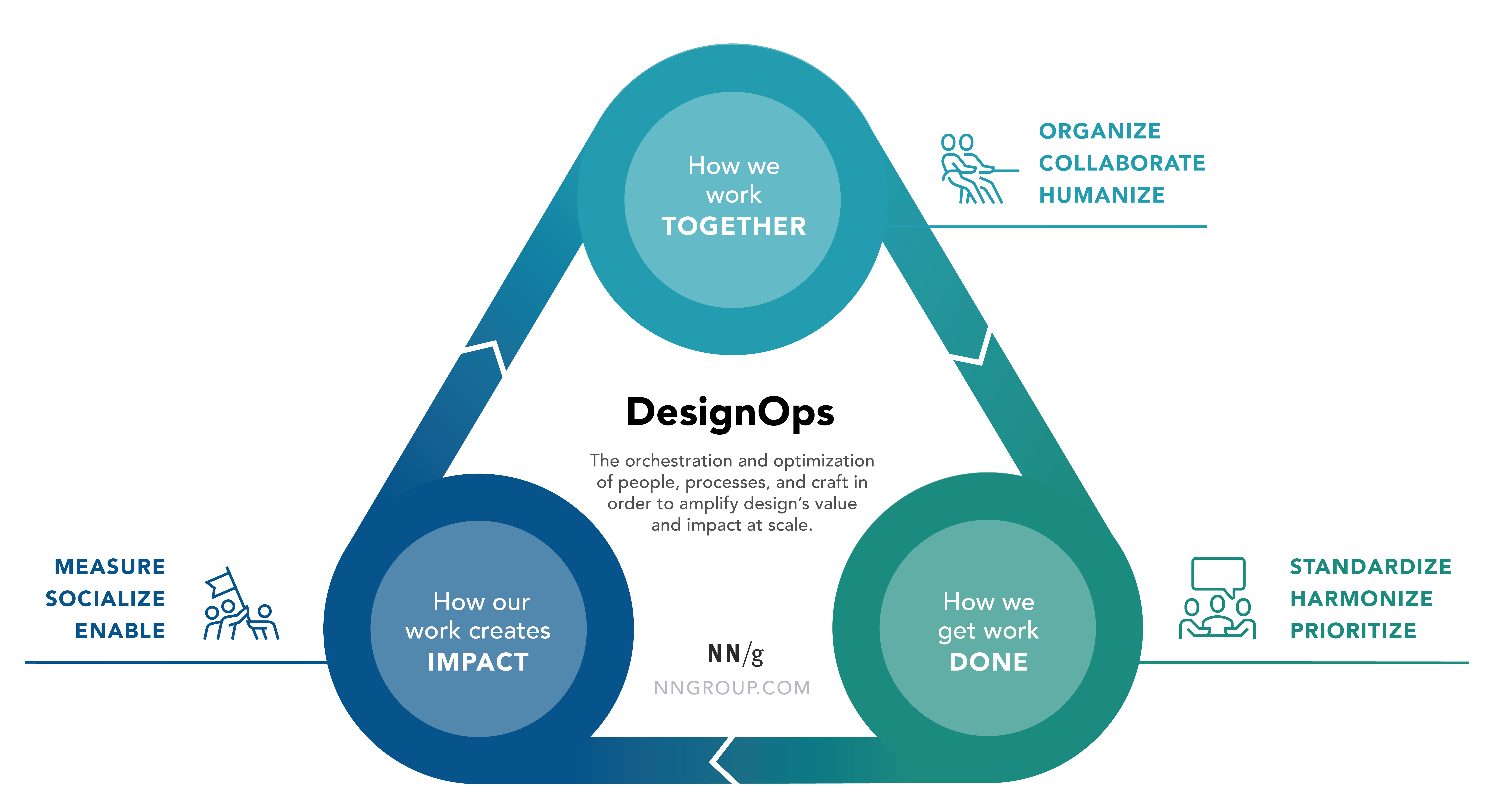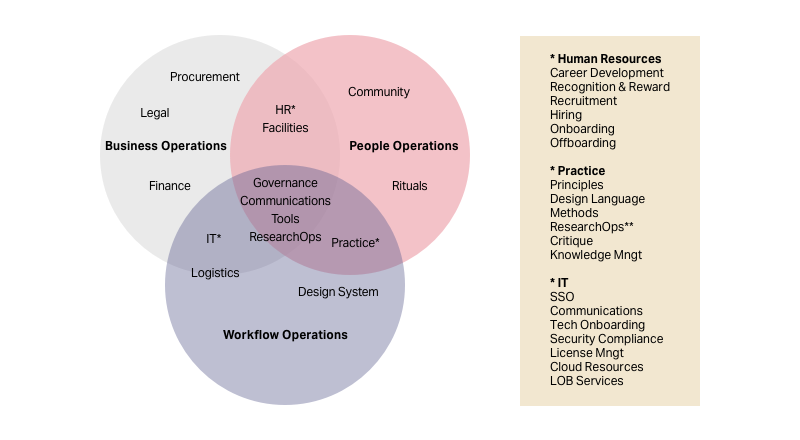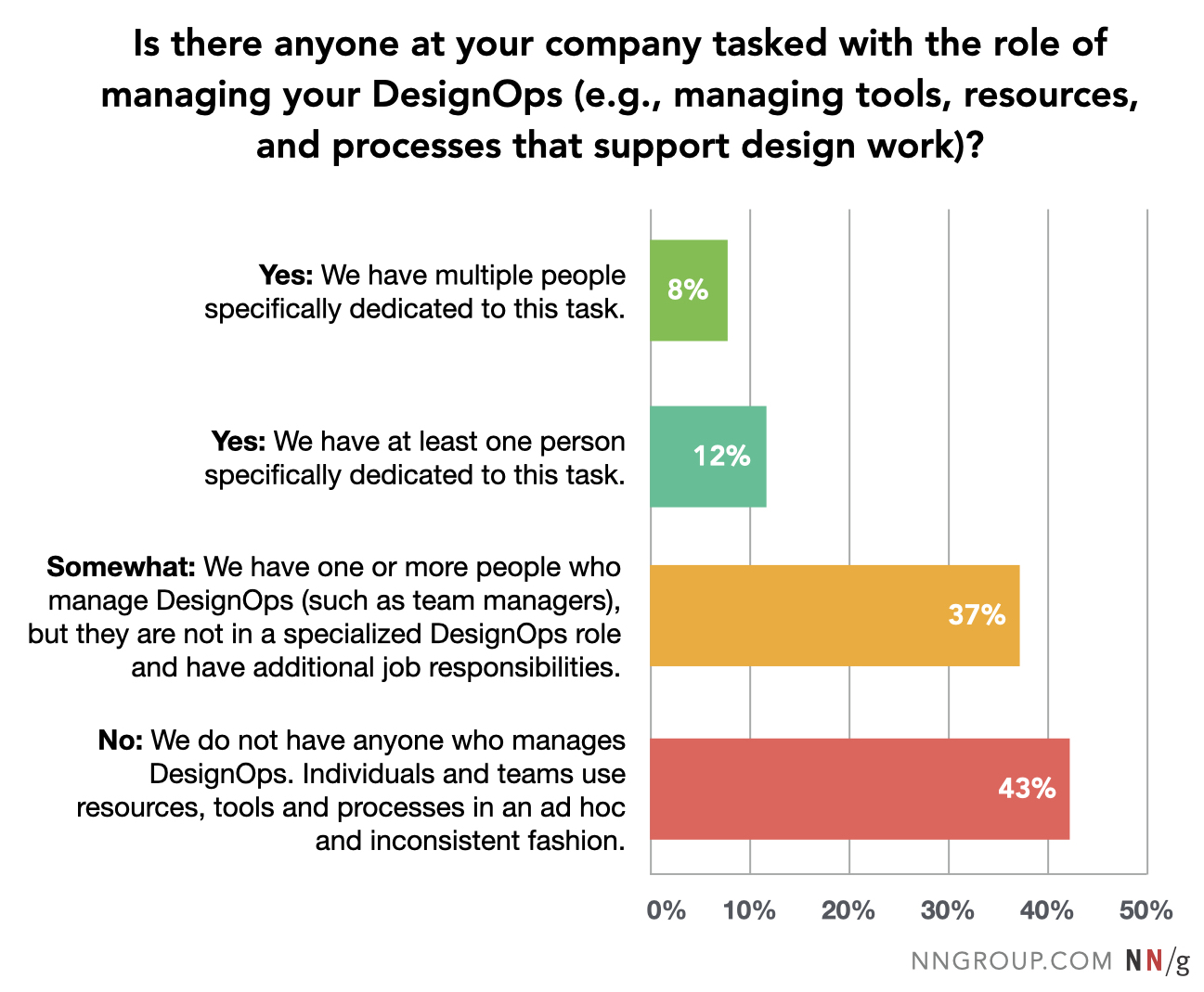The term DesignOps, for Design Operations, appeared a few years ago, it has gradually developed in companies, such as at Airbnb, which was one of the first to adopt this concept in 2015 and which serves as a model on the subject. In principle, the term seems to be developing and attracting companies. Yet, a recent study conducted by the NNGroup in June 2020 showed that the number of companies having one or more people dedicated to the DesignOps role is still relatively low.
So, does DesignOps really have an added value to bring to companies?
#1 Origin: The interest of a DesignOps?
The appearance of DesignOps responds to a number of observations in companies and design teams, which are growing and gaining in complexity:
- The multiplicity of project teams working in silos on different subjects but with common issues
- The multiplicity of design profiles: UX Designer, UI Designer, UX Writer, UX Researcher, Interaction Designer, etc.
- The proliferation of methods and tools available
- The popularization of the Design System
- The desire for homogeneity between the various products of the same group
- The geographical spread of the different designers: spread over different sites, remotely, internationally, in agencies, freelancers, etc.
- A “design culture” not always fully implemented in companies
All these issues lead to the desire to create cohesion between the different teams, but also to establish good practices and common tools within a group.
It is in this context that DesignOps takes its place, with the aim of structuring and standardizing design work across the company, so as to provide a more global and strategic vision.
The fact of delegating these tasks to a dedicated pole is not only a good way to guarantee strong homogeneity within the company, but it also allows designers to offload the challenges of organizing and planning design work. , and sometimes involvement in internal politics to have to obtain budgets dedicated to design or research.
#2 Missions: and concretely, what does it do?
Dave Malouf, one of the great pioneers of DesignOps, defines DesignOps like this: “DesignOps is everything that supports high quality crafts, methods, and processes. »
The role of DesignOps is to lead a team of designers so that everyone can find their place, to create synergy between the teams, to put in place the right tools to facilitate homogenization within the group, but also to ensure the larger-scale impact of design work.
The NNGroup categorizes DesignOps functions into three categories:
The role of DesignOps by NNGroup
Depending on the companies, their organization, their sector of activity, their maturity, the objectives are not the same, and that is why from one company to another, the role of DesignOps can be very different.
Here are some examples of concrete tasks that can be entrusted to DesignOps :
- anticipating design needs at group level,
- recruit UI designers, UX designers, UX researchers, etc. according to needs,
- set up a design system and keep it up to date, adapt it to project needs,
- be responsible for sharing and implementing best practices in all teams,
- choose the most suitable design tools and standardize them with the teams,
- organize weekly meetings between designers to discuss current projects,
- monitor long-term projects,
- identify possible points of synchronization between different teams and connect them,
- survey designers on assignment to identify their difficulties and help them implement solutions,
- evangelize within business teams in the company, in order to make people understand the importance of process design in projects.
However, this list is far from being exhaustive, as the tasks will vary from one context to another, and the emphasis placed on certain aspects rather than others, depending on the organization in place. One of the main qualities of DesignOps is therefore to know how to adapt and adjust its methods.
#3 Who is DesignOps?
The role of DesignOps can be carried out by a single person as well as by a group of people, for whom the missions are then distributed. It depends on the size, structure and needs of the organization.
However, the very varied nature of the heuristic tasks and the different skills required rather encourage, in sufficiently large companies, to have several dedicated people.
How DesignOps works, excerpt from DesignOps Handbook
According to Dave Malouf, in a sufficiently large company, the DesignOps pole can be divided into 4 sections (depending on the needs of the company):
- Management
- business
- Operational monitoring of design projects
- Research Ops
This therefore makes it possible to distribute the DesignOps tasks to dedicated and specialized people, each section can be covered by one or more people, depending on the needs of the company.
Once again, this model is generic, and it is up to each company to adapt its operation to its own constraints and aspirations.
#4 Assessment: An indispensable role?
According to a survey conducted by the NNGroup of more than 500 companies, 20% of companies employ one or more people dedicated to the role of DesignOps. Although this figure may seem quite low at first sight, it should however be qualified.
Indeed, in a number of companies, one or more people do some of these tasks, without calling themselves DesignOps. This may be the case, for example, of a Head of Design, a Chief Design Officer or even a design center when it comes to a group of people.
Moreover, the NNGroup study informs us that for 37% of companies, the role of DesignOps is well performed, but by people for whom this is not the initial role, and who therefore have DesignOps responsibilities such as “ aside” from their initial functions.
Excerpt from the results of the study conducted by NNGroup on the presence of DesignOps in companies
Although this is not necessarily the ideal configuration, we can understand that the term DesignOps can be difficult to understand for companies because its contours can appear blurred. However, the fact that its tasks are increasingly carried out in companies is indeed encouraging proof that the design culture and its good practices are developing more and more and are better understood.
The DesignOps trend should therefore continue to become more popular in the years to come, to provide companies with a development framework for their design activities.
In response to these growing needs among our customers, UX-Republic has created a training day dedicated to DesignOps activities so that our experts and business contacts can also be better equipped with the concepts and toolbox relating to design work. Design Ops.
To find out more about our training: https://training.ux-republic.com/
Some links to go further :
The DesignOps explained by NNGroup: https://www.nngroup.com/articles/design-operations-101/
Feedback from Airbnb : https://airbnb.design/designops-airbnb/
Testimonial : 6 months as DesignOps Manager https://uxdesign.cc/defining-designops-my-first-6-months-as-a-designops-manager-921285cc75c9
Blog by Dave Malouf : https://medium.com/amplify-design/
Interview with Meredith Black, who set up the DesignOps at Pinterest: https://www.designbetter.co/podcast/meredith-black
NNGroup study on the maturity of DesignOps In the enterprises : https://www.nngroup.com/articles/designops-maturity-low/
The DesignOps vision by Rick Johanson, DesignOps at Google:
https://medium.com/google-design/scaling-the-craft-of-design-490fdb0b567b
The DesignOps Handbook by Dave Malouf, Meredith Black, Collin Whitehead, Kate Battles, and Gregg Bernstein
https://www.designbetter.co/designops-handbook
See you tomorrow for new surprises on our UX-Republic Advent calendar!
Noémie MARTEL, UI-UX Designer @UX-Republic
UX/UI ECO-DESIGN # Paris
SMILE Paris
163 quay of Doctor Dervaux 92600 Asnières-sur-Seine
DESIGN THINKING: CREATING INNOVATION # Belgium
UX-REPUBLIC Belgium
12 avenue de Broqueville - 1150 Woluwe-Saint-Pierre
MANAGING AND MEASURING UX # Paris
SMILE Paris
163 quay of Doctor Dervaux 92600 Asnières-sur-Seine
DESIGN SPRINT: INITIATION & FACILITATION # Paris
SMILE Paris
163 quay of Doctor Dervaux 92600 Asnières-sur-Seine
UX-DESIGN: THE FUNDAMENTALS # Belgium
UX-REPUBLIC Belgium
12 avenue de Broqueville - 1150 Woluwe-Saint-Pierre
GOOGLE ANALYTICS 4 #Paris
SMILE Paris
163 quay of Doctor Dervaux 92600 Asnières-sur-Seine
ACCESSIBLE UX/UI DESIGN # Belgium
UX-REPUBLIC Belgium
12 avenue de Broqueville - 1150 Woluwe-Saint-Pierre
EXPERIENCE MAPPING # Paris
SMILE Paris
163 quay of Doctor Dervaux 92600 Asnières-sur-Seine
















